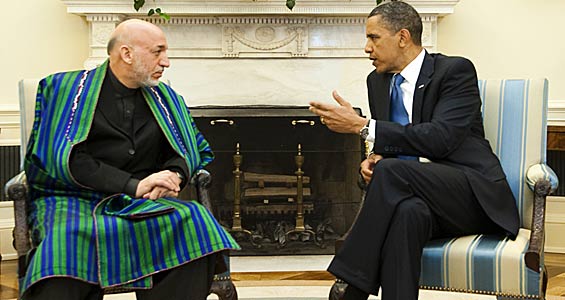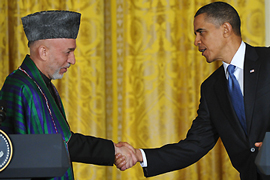Afghanistan’s governance problem
New US research concludes corruption and inefficiency still hallmarks of Afghan state.

 |
| Obama praised Karzai’s ‘commit[ment] to making good governance a top priority’ [AFP] |
There was a lot of optimistic language this week in Washington as Hamid Karzai, the Afghan president, met with Barack Obama, his US counterpart and other officials.
The US administration, eager to downplay a weeks-long rift with Karzai – which culminated with him threatening to join the Taliban – praised the Afghan president’s efforts to improve governance, bolster the rule of law, and deliver basic services.
Obama was also upbeat about the progress of his new war strategy in Afghanistan, unveiled about six months ago.
“We’ve begun to reverse the momentum of the insurgency,” he said.
That is perhaps a fair claim with a recent report from the US defence department concluding that instability in Afghanistan “has levelled off in many areas”.
However, while the Taliban may not be gaining ground anymore, neither is it losing territory.
And, according to two recent studies, this will continue to be the case until the Afghan government takes meaningful steps to strengthen its state institutions.
The defence department report, which was released last month, concludes that the government in Kabul has made little progress on reconstruction and anti-corruption efforts.
And a new study from the Center for American Progress (CAP), a liberal think-tank in Washington with close ties to the US government, concludes that the Obama administration relies too heavily on a corrupt, centralised Karzai government.
“Military operations alone will not create long-term stability in the country,” the report’s authors noted.
“[But] the system [the Afghan government] lacks the connection, rules, and checks and balances necessary to make leaders truly accountable to the domestic population.”
‘Dysfunctional’ government
The corruption in Afghanistan’s government is well-documented.
The United Nations said in January that Afghans paid roughly $2.5bn in bribes in 2009 – roughly one-quarter of the country’s gross domestic product.
Karzai’s government has approved a handful of reforms aimed at curbing that corruption – establishing an anti-corruption unit in the attorney general’s office, for example.
But their impact has so far been limited with 83 per cent of Afghans saying their daily lives are still affected by government corruption, according to a March 2010 survey.
 |
| The US defence department says local government is ineffective in most districts |
The US defence department surveyed 92 districts to gauge their feelings towards the government.
Not one district supported it, and only 44 expressed even a neutral opinion.
The rest were sympathetic to the Taliban.
Rampant corruption helps contribute to that widespread mistrust of the Afghan government, the report found.
So does a sense that the government isn’t providing services.
The defence department noted that local- and district-level development projects “were largely stalled” in late 2009, and most have yet to resume.
Rudderless ministries
As part of the defence department report, Nato assessed local governance in roughly 120 districts across the country.
It was rated as “unproductive” in one-third of the districts surveyed and “dysfunctional” in another 25 per cent.
Governance in 17 districts was simply described as “non-existent”.
At a national level, meanwhile, many ministries in Kabul find themselves rudderless six months after Karzai’s inauguration.
Nearly half of Afghanistan’s ministries have no permanent leadership.
The Afghan parliament has twice rejected large numbers of Karzai’s nominees, with the result that 11 of 25 positions remain unfilled.
Cabinet ministers are often viewed as more efficient than the president’s office – but the acting ministers who currently head many of Afghanistan’s ministries have little authority.
Afghans as ‘bystanders’
One reason for the corruption and inefficiency, according to the CAP study, is that the US and Nato have largely dictated the structure of the Afghan government – without significant input from the Afghan people.
“The corruption … [is] the result of a government structure shaped by international as well as domestic political actors’ behaviours and policies,” the CAP report said.
This has created what the authors, Caroline Wadhams and Colin Cookman, call an overly-centralised government that depends largely on one man: Hamid Karzai.
“All roads currently lead back to President Karzai, who directly appoints more than 1,000 government officials throughout the country and many more positions indirectly,” CAP wrote.
As a result, Karzai has few incentives to approve the kind of meaningful changes that would reduce corruption and improve governance.
Karzai bypassed
Neither Obama nor Karzai dwelled on these shortcomings – at least in public – over the last few days.
Obama praised his Afghan counterpart’s “commit[ment] to making good governance a top priority,” though he acknowledged that Karzai still needs to make more progress.
 |
| Obama and Karzai both sought to downplay recent tensions in their relationship [AFP] |
Behind the scenes, Obama almost certainly pressed Karzai on governance issues.
But administration officials acknowledge that they’re hesitant to place too much pressure on the president for fear they’ll lose his support altogether.
Instead there is a growing push to simply bypass Karzai – to empower local actors, instead of the central government, to provide security and services.
But these programmes have had mixed results and have made Karzai even more reluctant to work with Washington.
Armed groups
US and Nato commanders have eagerly endorsed a programme called the “Local Defence Initiative,” which arms local groups as a supplement to the national army and police.
Karzai – along with Karl Eikenberry, the US ambassador in Kabul – objected strongly to the measure.
Both men feared it would create unaccountable militias that ran amok and undermined the central government. The US implemented the plan anyway, over Karzai’s objections.
Early indications suggest that Karzai’s concerns were well-founded.
Nato’s decision to arm one such group, comprised of members of the Shinwari tribe in Nangarhar province, has resulted in tribal infighting that has killed more than a dozen people.
And the armed group has done little to reduce the Taliban’s presence in Nangarhar.
“In the interest of immediate results [the US] regularly bypass[es] the government in favour of key local powerbrokers,” the CAP report noted.
“No quick fix for long-term stability exists, however… [and] circumvention ultimately weakens the government.”
Karzai’s visit to Washington will help to reduce tensions in the US-Afghan relationship and represented a stylistic change for the Obama administration – from sticks to carrots.
But the substantive issues which caused that tension – the Afghan government’s corruption and its inability to deliver good governance – are still a long way from being resolved.